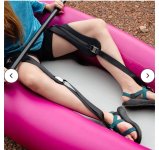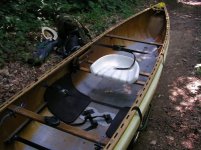I recently had the opportunity to use a borrowed inflatable kayak on some whitewater and I found the thigh straps intriguing. I was curious if anyone has ever given any thought to using something like these in a canoe. I thought I recalled reading a thread on it somewhere but could not find it. They look like they might be usable in a similar manner while seated in a canoe with a foot brace. Thigh straps in whitewater canoeing are very common of course, and go over the top of the thigh while kneeling on a saddle. These go on the inside of the thigh/knee area and hold the leg in contact with the side (see attached pic).
I do kneel sometimes in a regular canoe with a hung seat but I’m always a bit worried about entrapment under the seat in a pin situation. Additionally, I have some seats hung low enough that getting your feet under them is an issue, and I do not kneel with those for fear of entrapment (I know I could always raise them if I wanted). While seated in solos though, my knees are often in contact with the gunwales, and they are somewhat bent from using the foot brace. Seems like some padding on the gunwales and these thigh straps might add to stability and control and still be safer to get out of than kneeling under a web seat. They certainly made a huge difference in the IK. I did manage to flip it once and I came right out of the straps with no problems.
Seems like they could potentially be a good option for those that can’t kneel, have a pack canoe, or are just worried about entrapment. Easy to get on and off while under way and would probably hang out of the way when not in use. Not for serious whitewater use in place of a saddle and traditional straps, but for class II while tripping maybe? Curious what everyone’s thoughts are.
As an aside, those IK’s are much tougher than they appear from a distance. I won’t be giving up WW canoeing with a saddle any time soon, but it was a neat little boat to play with for a couple hours. Just a smaller/personal WW raft almost.
I do kneel sometimes in a regular canoe with a hung seat but I’m always a bit worried about entrapment under the seat in a pin situation. Additionally, I have some seats hung low enough that getting your feet under them is an issue, and I do not kneel with those for fear of entrapment (I know I could always raise them if I wanted). While seated in solos though, my knees are often in contact with the gunwales, and they are somewhat bent from using the foot brace. Seems like some padding on the gunwales and these thigh straps might add to stability and control and still be safer to get out of than kneeling under a web seat. They certainly made a huge difference in the IK. I did manage to flip it once and I came right out of the straps with no problems.
Seems like they could potentially be a good option for those that can’t kneel, have a pack canoe, or are just worried about entrapment. Easy to get on and off while under way and would probably hang out of the way when not in use. Not for serious whitewater use in place of a saddle and traditional straps, but for class II while tripping maybe? Curious what everyone’s thoughts are.
As an aside, those IK’s are much tougher than they appear from a distance. I won’t be giving up WW canoeing with a saddle any time soon, but it was a neat little boat to play with for a couple hours. Just a smaller/personal WW raft almost.


